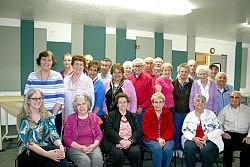St. Joseph the Worker to celebrate 50 years of heritage

WEST JORDAN — The Diocese of Salt Lake City is invited to attend the Jubilee celebration for Saint Joseph the Worker Parish May 2, beginning at 7 p.m. The Most Rev. John C. Wester, Bishop of Salt Lake City, will concelebrate a Mass with Father Patrick Carley, pastor. Diocesan archivist Gary Topping will be a guest speaker, and the St. Joseph the Worker Parish Archives will be blessed. A time capsule will also be buried to be opened at the 75th anniversary in 2039. The parish has its roots with the early South Valley Catholics who lived in small towns in the canyons of the Kennecott Copper mines, where they attended Holy Rosary Parish in Bingham. Immigrants came to Utah from Italy, Greece, Yugoslavia, China, Japan and Sweden to work the mines. There were also Hispanic Catholics from Mexico, California and Colorado. In the late 1950s and early 1960s the mines began to expand, and families had to move out of the canyon. As a result, Holy Rosary Parish was closed in 1958; its parishioners joined Immaculate Conception Parish in Copperton or Saint Therese of the Child Jesus Parish in Midvale. Father John Sullivan, pastor of Immaculate Conception, requested Bishop Joseph Lennox Federal build a Catholic church in West Jordan. Farmland was purchased in 1962 to establish St. Joseph the Worker. Construction on the church began July 1, 1964, and it was a mission of Immaculate Conception Parish until 1969. During construction, parishioners attended Mass in the Adondakis grocery store on 7800 South 1530 West. A parishioner of St. Therese of the Child Jesus, Louis Lopez joined St. Joseph the Worker to help establish the new parish. Attending Mass in the grocery store "was like attending church in a hall," he said. Edna Montoya Martinez was a member of Holy Rosary Parish before she and her husband and their nine children attended Immaculate Conception and then, in 1968, the family moved to West Jordan and joined St. Joseph the Worker Parish. The Martinez children received their sacraments at either Immaculate Conception or St. Joseph the Worker. Emma Serassio was a member of Immaculate Conception for 15 years and has been a parishioner of St. Joseph the Worker for 50 years. "We started the Folk Festival and other fundraisers back then," she said. Ruby Sato and Evila Garcia are two parishioners who moved to St. Joseph the Worker from Bingham. Their sons were altar boys, they said, adding that the boys would have to get out of school to serve at weddings and funerals. Both women have helped with funeral dinners from the beginning. "I used to wash and iron altar lines and help with the census; the people in the area were mostly farmers," Garcia said. "This parish has really grown; there are very few of us old ones left." The founding members were "a great faith community," said Father Patrick Carley, pastor, adding that they worked hard building the church with Fr. Sullivan as their foreman. "To this day St. Joseph the Worker has a strong, lively Catholic faith that was rooted from those founding families." The men donated their time and labor to build the parish hall, said Fr. Carley. "We now have a great men’s group and a lively women’s council here." St. Joseph the Worker is unique in that the people "have a strong sense of identity," said Topping. "They have a common history of being a working class. What we are is the influences of the past that have shaped our lives – you can’t understand who you are unless you understand your history." Records help people remember their history and "one reason the parish has a strong identity is because Anne Kurek [parish administrator] preserved those records and created the parish archives," Topping said. "History happens every day and we are such an historic Church; almost everything Catholics do, they do as a community." The working-class miners "stuck together through good times and bad times," said Kurek. "When the mine expanded, the mining families felt displaced until they all came together again at St. Joseph the Worker Parish. They rebuilt a strong sense of community and caring there that has lasted for 50 years."
© Copyright 2024 The Diocese of Salt Lake City. All rights reserved.

Stay Connected With Us